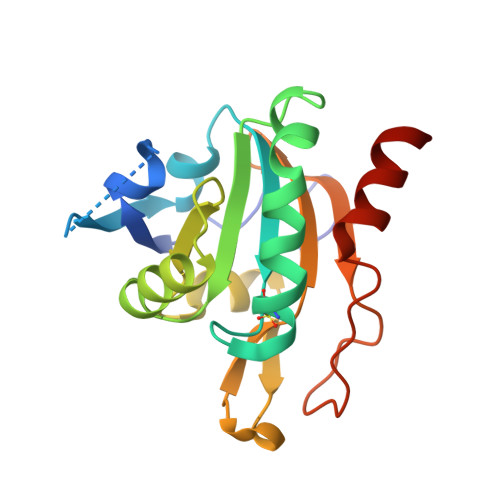Crystal structure of a novel Plasmodium falciparum 1-Cys peroxiredoxin.
Sarma, G.N., Nickel, C., Rahlfs, S., Fischer, M., Becker, K., Karplus, P.A.(2005) J Mol Biol 346: 1021-1034
- PubMed: 15701514
- DOI: https://doi.org/10.1016/j.jmb.2004.12.022
- Primary Citation of Related Structures:
1XIY - PubMed Abstract:
Plasmodium falciparum, the causative agent of malaria, is sensitive to oxidative stress and therefore the family of antioxidant enzymes, peroxiredoxins (Prxs) represent a target for antimalarial drug design. We present here the 1.8 A resolution crystal structure of P.falciparum antioxidant protein, PfAOP, a Prx that in terms of sequence groups with mammalian PrxV. The structure is compared to all 11 known Prx structures to gain maximal insight into its properties. We describe the common Prx fold and show that the dimeric PfAOP can be mechanistically categorized as a 1-Cys Prx. In the active site the peroxidatic Cys is over-oxidized to cysteine sulfonic acid, making this the first Prx structure seen in that state. Now with structures of Prxs in Cys-sulfenic, -sulfinic and -sulfonic acid oxidation states known, the structural steps involved in peroxide binding and over-oxidation are suggested. We also describe that PfAOP has an alpha-aneurism (a one residue insertion), a feature that appears characteristic of the PrxV-like group. In terms of crystallographic methodology, we enhance the information content of the model by identifying bound water sites based on peak electron densities, and we use that information to infer that the oxidized active site has suboptimal interactions that may influence catalysis. The dimerization interface of PfAOP is representative of an interface that is widespread among Prxs, and has sequence-dependent variation in geometry. The interface differences and the structural features (like the alpha-aneurism) may be used as markers to better classify Prxs and study their evolution.
Organizational Affiliation:
Department of Biochemistry and Biophysics, Oregon State University, 2011 ALS, Corvallis, OR 97331-7305, USA.















